
The fourth gathering of the Lausanne Movement will be held in Seoul, Korea September 22 – 28; the first was held in Lausanne, Switzerland in 1974. Thousands of delegates will attend from all parts of the world.
I began this series on ‘Christianity: a missionary religion’ in the lead-up to Mission Fest (February 15 – 17), both to remind people it was coming and to offer some insights into our rich missionary history and some of the issues and prospects as we move ahead. This is the final instalment.
The series
• Introduction
1. History of Missions
2. State of World Christianity
3. Specific Areas: Africa
4. Specific Areas: Asia
5. Specific Areas: Latin America
6. Not So Good News
7. New Approaches to Missions
I am looking mainly at some of the new books covering these various areas, but will also try to cover a few key themes along the way. It probably goes without saying that I will just scratch the surface of each topic – but I do hope that people will go on to read some of the books, which are of high quality.
VII. New Approaches to Missions
Most of the books I have looked at in the previous six parts of this series have been concerned with missions and missionaries in the past, especially over the past two centuries. It is important that we recognize how the church has grown globally, and who was responsible for that growth.
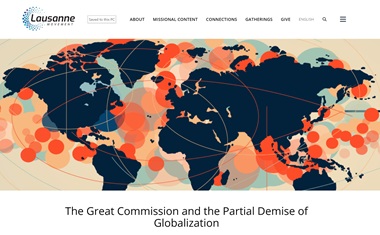 But the world has changed dramatically, and God is leading us in new ways. In a recent article for the Lausanne Movement, Patrick Johnstone, author emeritus of the influential Operation World, states:
But the world has changed dramatically, and God is leading us in new ways. In a recent article for the Lausanne Movement, Patrick Johnstone, author emeritus of the influential Operation World, states:
We need to recognize that the patterns for the ministry of churches and missions that have worked reasonably well for 200 years have largely gone for ever. The Great Commission is just as valid today and we still face an unfinished task that should drive us to our knees. We must still obey that last command of Jesus – but how?
We need to look again at the emphases we find in that Commission and apply these to our changed world. The expression ‘go and make disciples of all nations’ is all-too-often distorted in translation because our grammars do not allow for the Greek verb to be translated as a verb. If we do, it becomes ‘in going, disciple all peoples.’ This significantly changes the application of this command! Every Christian body should be globally missional, but few are truly so.
-
- The active ministry is ‘to disciple,’ but this is the one thing very few churches or leaders focus on. My life aim has been to have disciples that extend to the fourth generation, as in 2 Timothy 2:2, but this took 60 years of ministry to see it realized.
- ‘In going’ implies that the ‘going’ is assumed for all believers. Discipling should be a fundamental component and purpose of every secular and spiritual activity in ministry.
- ‘All nations’ means discipling both individuals and the social fabric of peoples and nations. It is not just the personal extractions of some out of society. Christians should seek to mould others with (and be moulded by) the kingdom values of honesty, integrity, love and care for the less fortunate, proclaiming an eternal hope.
He goes on to speak of ‘the breakdowns of globalism,’ referring to 1. the ravages of war; 2. migrations; 3. economic crises; 4. climate change; 5. Islam; 6. population collapse; and 7. people and language extinctions. He feels the UN has been seriously damaged, particularly by its mishandling of the Russian invasion of Ukraine. “Two major aspects of globalization I foresee as likely to thrive,” he says: “the Internet Empire” and “the Global Church.”
Here are six books which illustrate various elements of current mission thinking – global mobilization; reconciliation; disciple-making / church planting; witness to Muslims; engaging with members of the diaspora in our neighbourhoods; and reckoning with the unexpected results of missionary activity, both at home and abroad.
- Ryan Shaw: Rethinking Global Mobilization: Calling the Church to Her Core Identity (Ignite Media, 2022)
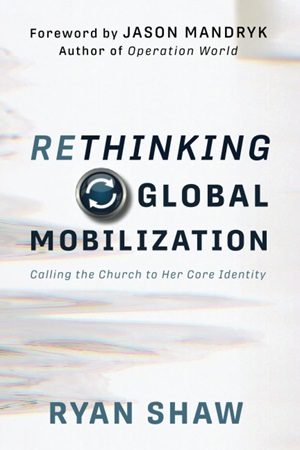 Ryan Shaw is very much focused on the Great Commission. While studying at Fuller Theological Seminary, he “stumbled upon” the Student Volunteer Movement (SVM) and its compelling catchprase: “The evangelization of the world in this generation!” – which he said (quoting David Howard) “catalyz[ed] more than 20,000 cross-cultural workers to the ends of the earth” between 1886 and 1940.
Ryan Shaw is very much focused on the Great Commission. While studying at Fuller Theological Seminary, he “stumbled upon” the Student Volunteer Movement (SVM) and its compelling catchprase: “The evangelization of the world in this generation!” – which he said (quoting David Howard) “catalyz[ed] more than 20,000 cross-cultural workers to the ends of the earth” between 1886 and 1940.
Shaw lives with his family in Chiang Mai, Thailand, and is International Lead Facilitator of Global Mission Mobilization Initiative (GMMI).
He writes in Rethinking Global Mobilization:
I was captivated seeing from Scripture the realistic possibility of the literal fulfillment of Jesus’ Great Commission. . . . Today, the global Church exists in some form in all 196 countries of the world. The move of the Spirit over the last 100 years has dynamically prepared the global Church for realizing the fulfillment of the Great Commission – but only as she is deliberately mobilized and equipped to emphasize her primary calling.
Shaw posted ‘Mobilization: the key to the mission movement’ on the GMMI site just this week:
It is vital to understand the historical progress of the modern mission movement to grasp where the global Church presently is right now in its expansion. Launched through William Carey in 1792, the Western mission thrust initially came primarily from the United Kingdom, United States and Canada.
This led to what some historians have called the “Great Century of Missions” in the 1800s, where Western missionaries preached the Gospel, planted churches, started schools and established hospitals across Asia, Africa and Latin America.
With the coming of the 1900s, its two massive World Wars and the political upheaval that allowed Communism to take root in many portions of the world, the Western mission movement continued, yet was hindered, stifled.

Following his conversion, Yosiya Kinuka (driving) led many evangelistic missions during the East African Revival in the 1930s..
This opened the way for another phenomenon. The Gospel that had been introduced during the 1800s in many cultures across Asia, Africa and Latin America, spread like wildfire indigenously in the 1900s. This produced significant indigenous churches in many traditionally mission-receiving parts of these continents. . . .
Although the gospel of Jesus Christ, and the spread of the Kingdom of God, has seen incredible expansion into new cultures all over the world over the last 300 years – with some believers now in every geo-political country – in 2024, still about one-third of the total global population are located among unreached people groups.
What do these two extraordinary facts (believers now in every nation and yet still a third of the population unreached) reveal to us about God’s plan to fulfill the Great Commission?
That a key ministry in the global Church today must be that of focused and deliberate mission mobilization among the current national churches, primarily in the spiritually exploding global south – Asia, Africa and Latin America.
Go here for the full comment.
“In Rethinking Global Mobilization, you will learn about God’s big-picture, comprehensive, holistic intent for mission mobilization as calling the global Church to her core identity, in contrast to the common, yet limiting, understanding of mobilization as primarily recruiting individual workers.”
- Geoff Hartt, Michael A. Ortiz, Manuel Böhm, editors: Ambassadors of Reconciliation: God’s Mission Through Missions for All (William Carey Publishing, 2023)
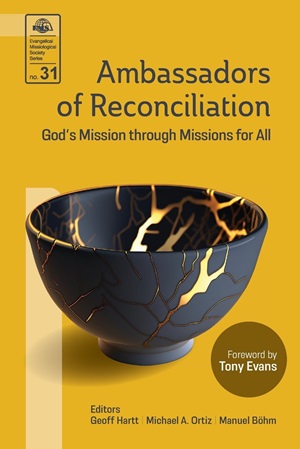 “What does reconciliation have to do with the work of missions? In today’s conflict-ridden world, the concept of reconciliation has gained traction, and Christian missions is being rethought. The whole world cries out for holistic transformation with eternal value, and God’s people are called to be his ambassadors.
“What does reconciliation have to do with the work of missions? In today’s conflict-ridden world, the concept of reconciliation has gained traction, and Christian missions is being rethought. The whole world cries out for holistic transformation with eternal value, and God’s people are called to be his ambassadors.
“Ambassadors of Reconciliation lays the groundwork for exploring a new paradigm for missions. Divided into three parts, the book first establishes the theological foundations of reconciliation.
“The second part then shows how theory and practice go hand in hand. Finally, the third part uses case studies to highlight the importance of understanding brokenness, conflict and culture for effective ministry in reconciliation.
“The contributors challenge readers to consider the church’s role in God’s mission and how every Christian can become an envoy of his restoration work. They emphasize the spiritual dimension of reconciliation and offer practical guidance for effectively engaging in ministry.
“Whether you are a missionary, pastor or someone interested in promoting restoration in the world, this book provides valuable insights and tools for your journey.”
Manuel Böhm is a member of the Peace and Reconciliation Network (PRN), a commission of the World Evangelical Alliance (WEA). The Global Director of PRN for North America is Phil Wagler, who spent almost a decade in this area as pastor of Grace Community Church in Surrey and as a Lead Team member with Multiply; he is now based in Kelowna.
- Murray Moerman: Mobilizing Movements: Leadership Insights for Discipling Whole Nations (William Carey Publishing, 2021)
Murray Moerman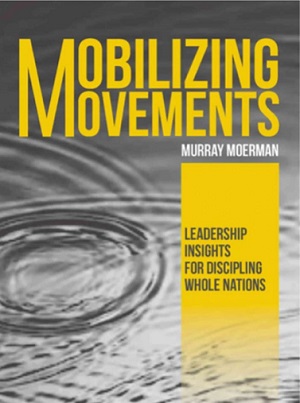 is well known locally as a church planter, pastor and networker. He and his wife Carol are also known around the world for their leadership role with Global Church Planting Network (GCPN) and other national church planting process initiatives.
is well known locally as a church planter, pastor and networker. He and his wife Carol are also known around the world for their leadership role with Global Church Planting Network (GCPN) and other national church planting process initiatives.
I posted an article about the book here, and following is the publisher’s description.
“As record numbers of people around the world respond to Christ, a need for community, structure and leadership is emerging. Disciple-making and church planting must extend to the most remote areas of every people group and nation to assist individuals as they come to Christ.
“Lasting movements build on specific traits and strategies in both teams and leadership, including divine passion that lasts beyond whims and hardships.
“Murray Moerman provides realistic expectations of what it takes to facilitate a movement and how to gain the support of various partners needed for long-term success, resulting in whole-nation church planting saturation. Based on years of research, Mobilizing Movements contains both practical and spiritual elements. You will find insights and models from several continents for macro (whole nation) strategies and micro (personal) disciple-making.
Features of Mobilizing Movements include:
- Key component of healthy movements
- Nine accelerants for movements
- Analysis of seven challenging contexts in which movements can still flourish
- Practical strategies scalable to your capacity and context
Writing for novices as well as practitioners, Moerman casts a vision for completing the Great Commission and invites us to mobilize movements.”
- Gene Daniels, Pam Arlund, Jim Haney, editors: Fruit to Harvest: Witness of God’s Great Work Among Muslims (William Carey Press, 2019)
 “Fruit to Harvest is a cultural anthology written by a diverse group of gospel workers who live with and love Muslims. You will join a global mission conversation at the forefront of gospel advance – the world of Islam. Like its predecessor (From Seed to Fruit), this book is the result of a global consultation sponsored by the Vision 5:9 Network.
“Fruit to Harvest is a cultural anthology written by a diverse group of gospel workers who live with and love Muslims. You will join a global mission conversation at the forefront of gospel advance – the world of Islam. Like its predecessor (From Seed to Fruit), this book is the result of a global consultation sponsored by the Vision 5:9 Network.
“This volume is a storehouse of missiology that offers:
• Reflections from 47 writers hailing from 21 different countries
• Fresh case studies from the field of Muslim ministry
• Strategies for overcoming barriers to reaching Muslims
• Insights from hundreds of testimonies taken from field workers in 30 different agencies working across the Muslim world.”
Don McCurry gives credit to “the early Protestant mission stalwarts” who began to engage Muslims in the 1800s – Carl Pfander, Thomas Valpy, Samuel Zwemer – and some of the ways in which their pioneering work has been followed up on.
In his essay, ‘Extraordinary Boldness to Muslim Peoples,’ Jim Haney adds several other early leaders, including Raymond Lull, H.H. Jessup, Zwemer again and Don McCurry himself. Haney offered counsel from his ‘guests.’
For example, he had Samuel Zwemer say that at the breakthrough Edinburgh World Missionary Conference in 1910, the community had felt itself to be on the brink of a new surge of missionary advance. Sadly, Satan undermined their resolve through genocide, war depression and more. ‘Zwemer’ concludes:
So what counsel can I bring you? The hour remains momentous – your hour. My counsel? Don’t waste your present hour; use your time rightly to awaken the church; do not abandon your post.
In ‘Gospel Advance Among Muslim peoples,’ Haney says the primary goal of Vision 5:9 is “to see effective church planting efforts among all Muslim peoples. By the grace of God, we aspire to see this accomplished by 2025.”
Pam Arlund, in ‘Opportunities and Threats in the Muslim World,’ writes:
There is danger that some Christians will not send their missionaries to love Muslims due to danger. To them, the advice of Ralph Winter [key advocate for outreach among unreached people groups and founder of the U.S. Center for World Mission] is highly relevant: “Risks are not to be evaluated in terms of the probability of success, but in the value of the goal.” The goal, Jesus being worshiped by all the peoples of the earth, is worth everything.
- Winfried Corduan: Neighboring Faiths: A Christian Introduction to World Religions (IVP, 2024)
 The third edition of Neighbouring Faiths is due out in April. It helps us to address the reality that missions is no longer primarily from the West to the rest, but an immediate reality right next door. One of the greatest weaknesses of the missionary movement has been that workers were often sent out unprepared. We can be prepared – and we don’t necessarily have to go anywhere.
The third edition of Neighbouring Faiths is due out in April. It helps us to address the reality that missions is no longer primarily from the West to the rest, but an immediate reality right next door. One of the greatest weaknesses of the missionary movement has been that workers were often sent out unprepared. We can be prepared – and we don’t necessarily have to go anywhere.
“World religions are not merely abstract sets of doctrinal beliefs. They are embodied worldviews and practices lived out by real people around us. Encounters with these neighboring faiths often challenge our own beliefs and traditions, making us think more deeply about our faith commitments.
“For all who want to understand the religious faiths of their neighbors, Winfried Corduan offers an introduction to the religions of the world. This classic text covers major as well as lesser known religions, including Judaism, Islam, Zoroastrianism, African traditional religions, Native American religion, Hinduism, Buddhism, Jainism, Sikhism, Baha’i, Chinese popular religion and Shinto and Japanese religions.
“Neighboring Faiths emphasizes not just formal religious teachings but also how each religion is practiced in daily life. Dozens of photographs, charts and maps help illustrate how the faiths have developed and how they’re lived out today. Corduan offers specific insights into what to expect from encounters with adherents of each religion and suggestions for how Christians can engage them in constructive dialogue.
“Each chapter offers lists of key points, ideas for term papers and recommended resources to help students, instructors, and small groups go deeper. Neighboring Faiths is an indispensable guide for Christians seeking an informed, empathetic perspective on different religions and the people who practice them.”
- David A. Hollinger: Protestants Abroad: How Missionaries Tried to Change the World but Changed America (Princeton University Press, 2017)
 I could have included Protestants Abroad last week, under the heading ‘Not So Good News.’ It’s an excellent missions-related book, one of my favourites.
I could have included Protestants Abroad last week, under the heading ‘Not So Good News.’ It’s an excellent missions-related book, one of my favourites.
The bad news was that missionaries were sent over unprepared, unduly tied to the American way of life, with an unexamined sense of cultural superiority.
The good news is that they returned chastened, with a much enlarged view of the world, for which some of them became ‘evangelists.’
More bad news though – they often lost the sense that they had ostensibly been on God’s mission, which is in fact superior to all others.
“Between the 1890s and the Vietnam era, many thousands of American Protestant missionaries were sent to live throughout the non-European world. They expected to change the people they encountered, but those foreign people ended up transforming the missionaries.
“Their experience abroad made many of these missionaries and their children critical of racism, imperialism and religious orthodoxy. When they returned home, they brought new liberal values back to their own society.
Protestants Abroad reveals the untold story of how these missionary-connected individuals left an enduring mark on American public life as writers, diplomats, academics, church officials, publishers, foundation executives and social activists.
“David A. Hollinger provides riveting portraits of such figures as Pearl Buck, John Hersey and Life and Time publisher Henry Luce, former ‘mish kids’ who strove through literature and journalism to convince white Americans of the humanity of other peoples.
“Hollinger describes how the U.S. government’s need for citizens with language skills and direct experience in Asian societies catapulted dozens of missionary-connected individuals into prominent roles in intelligence and diplomacy.
“Meanwhile, Edwin Reischauer and other scholars with missionary backgrounds led the growth of Foreign Area Studies in universities during the Cold War. The missionary contingent advocated multiculturalism and anticolonialism, pushed their churches in ecumenical and social-activist directions, and joined with Jewish intellectuals to challenge traditional Protestant cultural hegemony and promote a pluralist vision of American life. Missionary cosmopolitans were the Anglo-Protestant counterparts of the New York Jewish intelligentsia of the same era.
“Protestants Abroad reveals the crucial role that missionary-connected American Protestants played in the development of modern American liberalism, and how they helped other Americans reimagine their nation’s place in the world.”
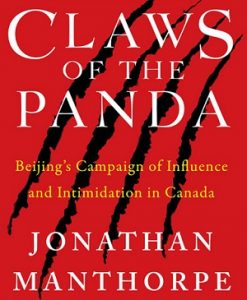 I wrote about a similar phenomenon in Canada, in ‘Claws of the Panda: the curious role of ‘Mish Kids’ in Canada’s China Policy.’
I wrote about a similar phenomenon in Canada, in ‘Claws of the Panda: the curious role of ‘Mish Kids’ in Canada’s China Policy.’
Claws of the Panda examines the role of missionaries in turning our attention to China in the first place and in assessing (not always wisely in Manthorpe’s opinion) China’s influence on Canada over the past 100 years or so.
He said:
Thus, the missionaries and their offspring, brought up in China, fluent in the language and cultures – the so-called Mish Kids – were instrumental in shaping public support for the early recognition of the People’s Republic of China after the Communist Party took power in 1949.
Sympathy for the CCP among the Mish Kids stemmed from two sources: antipathy toward the neo-fascist Kuomintang and politically left of centre interpretations of Christianity among Methodists and the United Church of Canada.
The Mish Kids and other scions of the Methodists, in particular, had a significant presence in the Department of External Affairs in the 1930s, 1940s and 1950s. They also played major roles in the evolution of Canada’s independent foreign policy after the Second World War.
But as the book’s subtitle – ‘Beijing’s Campaign of Influence and Intimidation in Canada’ – suggests, while Manthorpe clearly recognizes the international role of missionaries, he is not necessarily a fan. He does underestimate the influence of missionaries on China, the long-term effects of which have yet to be realized.
An expanded and updated version of Claws of the Panda will be released in May.
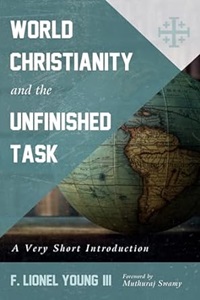 Several of the books I have written about earlier in this series would fit well in this section. In particular, from Part I:
Several of the books I have written about earlier in this series would fit well in this section. In particular, from Part I:
- F. Lionel Young III: World Christianity and the Unfinished Task
- Timothy Tennent: How God Saves the World
- D.C. Keane: Uncharted Mission: Going to the Final Frontiers
- Christopher J.H. Wright: The Great Story and the Great Commission
- Tim Keesee: A Company of Heroes: Portraits from the Gospel’s Global Advance
Good links
I have pointed to many good books about missions in this series, but probably the best place to gain more insights into the modern missionary movement is by signing up to receive updates from some of the really interesting sites online. Here are some I like:
- Lausanne Movement
This September, the Lausanne Movement will host the Fourth International Congress on World Evangelization, Seoul-Incheon 2024, in South Korea. This is just the fourth Congress since the first one in Lausanne, Switzerland 50 years ago, in 1974. I attended the last gathering, in Cape Town, South Africa, in 2010 and it was quite a stirring experience.
Here are a few recent articles which give a sense of Lausanne’s approach:
- The Fourth Lausanne Congress: From Switzerland to Satellite Sites
- God’s Mission Needs the Right Message
- The Lausanne Movement’s Global Reach in 2023
- Lausanne Movement Missional Content
 Browse more than 40 years of missional resources from across the Movement. An advanced search is also available with filters by content format, topic, related gathering or other special grouping.
Browse more than 40 years of missional resources from across the Movement. An advanced search is also available with filters by content format, topic, related gathering or other special grouping.
- WEA Global Witness
The Global Witness Department of the World Evangelical Alliance (WEA) connects with leaders of Evangelical Missionary Alliances, missions movements, networks, agencies and churches to reflect on current missions and evangelism practice and provide resources that strengthen participation in God’s mission locally and globally. Subscribe for news.
- Mission Hits
Mission Hits is a monthly blog highlighting stimulating and significant recent resources related to world mission and world Christianity. An amazing resource run by Chris Howles (From Every Nation).
is a monthly blog highlighting stimulating and significant recent resources related to world mission and world Christianity. An amazing resource run by Chris Howles (From Every Nation).
- Missions Catalyst
Missions Catalyst is a free, weekly electronic digest of mission news and resources designed to inspire and equip Christians worldwide for global ministry. Use it to fuel your prayers, find tips and opportunities and stay in touch with how God is building his kingdom all over the world.
- Joshua Project
Joshua Project is a research initiative seeking to highlight the people groups of the world with the fewest followers of Christ. Accurate, updated people group information is critical for understanding and completing the Great Commission. Revelation 5:9 and 7:9-10 show that there will be some from every tribe, tongue, nation and people before the Throne.
Books to start with
Back to books. I have focused mainly on academic books and, this week, books for the already missions-minded. There are, of course, also many books for readers who simply want to get a taste of missionary lives. Here are a couple of great sets for kids.
- Dave & Neta Jackson: Trailblazer Books
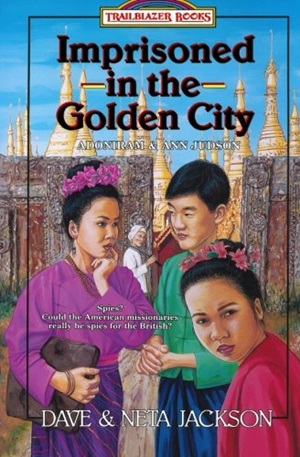 Dave and Neta Jackson have written 40 Trailblazer Books – “action-packed historical fiction introducing great Christian heroes.” The books cover a wide range of historical figures, many of whom were missionaries. Among them are David Livingstone, Mary Slessor, Gladys Aylward, Nate Saint and Amy Carmichael.
Dave and Neta Jackson have written 40 Trailblazer Books – “action-packed historical fiction introducing great Christian heroes.” The books cover a wide range of historical figures, many of whom were missionaries. Among them are David Livingstone, Mary Slessor, Gladys Aylward, Nate Saint and Amy Carmichael.
Here is the description of Imprisoned in the Golden City:
The two young Burmese girls had dreaded leaving their father but he told them that the only safe thing was for the two of them to go live with the American missionaries, Adoniram and Ann Judson. May-Lo and Len-Lay really aren’t sure what the danger is, and they don’t know what to believe about their American foster parents. Could the accusations that the missionaries were English spies be true?
When the Judsons leave the city of Rangoon to establish a mission work in Ava, the Golden City, the girls are taken along on the dangerous river trip that will separate them from their father by 350 miles. Will they ever see him again? Will they even make it to their destination? How will the emperor of Burma respond to Mr. Judson’s petitions to give religious freedom to Christian converts?
Their arrival is followed by eventual disaster. When the British attack the Burmese, all the white foreigners, including Adoniram Judson, are hauled off to the terrible Death Prison. Every clue indicates that the Judsons are spies, and a Burmese-English boy named Myat Rodgers is determined to prove their guilt. Should the girls tell the authorities what they know? Or will they all end up in the Death Prison?
Without their father’s help, whom could they trust?
Apparently the series has sold 1.8 million copies. They obviously don’t tell the full story, but they’re a great start. The Jacksons have also published four volumes of Hero Tales, each featuring 15 figures, including some of the ones mentioned above, along with Eric Liddell, Hudson Taylor, Mother Teresa and many more.
- YWAM Publishing: Christian Heroes
 Not too surprisingly, YWAM Publishing also offers missions books for young readers (10+). The Christian Heroes: Then & Now series actually has 50 of them, listed chronologically here. Not all are missionaries – C.S. Lewis and Dietrich Bonhoeffer, for example – but the majority are.
Not too surprisingly, YWAM Publishing also offers missions books for young readers (10+). The Christian Heroes: Then & Now series actually has 50 of them, listed chronologically here. Not all are missionaries – C.S. Lewis and Dietrich Bonhoeffer, for example – but the majority are.
Like the Trailblazer series, Christian Heroes books are written by a husband and wife team Janet and Geoff Benge.
Here is the write-up for Vancouver’s very own Isobel Kuhn:
A fellow missionary had said, “When you get to China, all the scum of your nature will rise to the top.” It surely had, mused Belle. The food, the fleas, the filth, the exhausting mountain paths, and so many other transitions to missionary life had tested her. But Belle had stayed at her post, and she was so glad that she had.
As a 14 year old intent on living a ‘modern’ life, the last thing Isobel Kuhn wanted to grow up to be was a missionary. But as it turned out, this young agnostic’s life was redirected – from crisis and doubt to hope and strength.
Convinced that God wanted her to preach the gospel as a China Inland missionary, Isobel bravely served among the Lisu people in remote mountainous regions of China and Thailand. After 20 years of ministry Isobel returned to the United States, writing stirring stories of faith and inspiring generations of readers (1901 – 1957).
I’ve enjoyed the Trailblazer and YWAM books that I’ve read, as have my children and grandchildren.
- Jason Mandryk & Molly Wall, editors: Window on the World: An Operation World Prayer Resource (IVP Books, 2018)
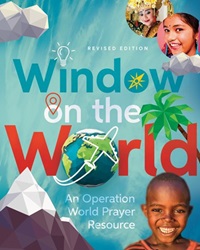 Here’s one more. I haven’t tested it at home, but it looks really good.
Here’s one more. I haven’t tested it at home, but it looks really good.
“Window on the World is your ticket to travel around the world! If you appreciate Operation World as an adult, your kids will love this invaluable and age-appropriate prayer resource that develops cultural, political, and geographical awareness through a Christian lens. Find out how God is changing the lives of families everywhere through prayer—from the frozen Arctic to the hottest desert, on the highest mountains and in crowded cities.
Window on the World brings alive the culture, history, and traditions of all sorts of different people. With “Fact Files” and “Do You Know?” features, each section brings you information, true stories, maps, and easy-to-use prayer points that take you into homes around the world. See how children live, what they like to do, where they go to school, what they eat and wear, and what they hope and dream.”
Missions books for adults
Here are a few non-academic missions books that have stuck with me; there are many more good ones.
- Andrew Adam: Thomas Cochrane and the Dragon Throne (SPCK, 2018)
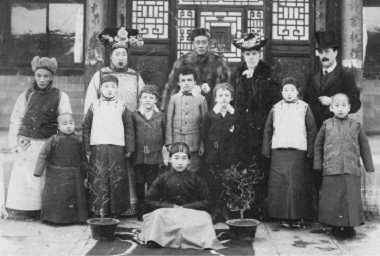
Thomas and Grace Cochrane with their children and a high-ranked Chinese family.
Thomas Cochrane and the Dragon Throne tells one of the larger-than-life stories that missionary biographies often supply. The subtitle, ‘Confronting disease, distrust and murderous rebellion in Imperial China,’ does not overstate the case.
Cochrane was a poor boy from the docklands downriver from Glasgow who became a Christian during a D.L. Moody crusade. He worked hard to get through medical school so he could work in “the neediest place on earth.”
After serving for several years in a town on the border of China and Inner Mongolia, where he (with his wife and three very young children) survived several threats to his life, he was re-posted to Peking (now Beijing)
There he enlisted the help of the Empress Dowager and her highest courtiers as he founded China’s first medical college, which he then passed on to the Rockefeller Foundation so it could reach a higher potential.
I wrote about the book here.
- Tom Hiney: On the Missionary Trail: A Journey Through Polynesia, Asia and Africa with the London Missionary Society (Grove Press, 2001)
 Here are just a couple of the many glowing reviews:
Here are just a couple of the many glowing reviews:
“On the Missionary Trail . . . illuminate[s] the struggles of the nineteenth-century men and women who risked–and often lost–their lives to bring Christianity and civilization to the remotest corners of the earth.” – The Wall Street Journal
“Excellent… Hiney writes plainly and clearly. His story is crammed with drama and exotica… Hiney allows people and events to speak for themselves.” – TLS
“Hiney follows the intrepid travelers to such places as Tahiti, China, and the Kalahari Desert, where they confronted pirates, slavers, ravening animals, and ferocious storms, surviving all that God could throw at them for nearly eight years. . . . A solid history that will be particularly useful to students of colonialism.” – Kirkus Reviews
- Duncan Hamilton: For the Glory: Eric Liddell’s Journey from Olympic Champion to Modern Martyr (Penguin Press, 2016)
- Langdon Brown Gilkey: Shantung Compound: The Story of Men and Women Under Pressure (Harper & Row, 1966)
- David Michell: A Boy’s War (OMF Books, 1988)
 I wrote about these three books here. They all relate to missionaries (and others) held in a Japanese prisoner of war camp in China – and, in varying degrees, to Eric Liddell.
I wrote about these three books here. They all relate to missionaries (and others) held in a Japanese prisoner of war camp in China – and, in varying degrees, to Eric Liddell.
- Jay Milbrandt: The Daring Heart of David Livingstone: Exile, African Slavery and the Publicity Stunt that Saved Millions (Nelson Books, 2014)
“The untold story of the great explorer, David Livingstone, his faith and his heroic efforts to end the African slave trade. Saint. Missionary. Scientist. Explorer. The titles applied to David Livingstone since his death are eclectic enough to seem dubious, and with good reason.
“In view of his own journals, saint is out of the question; even missionary is problematic when one considers his conversion record. But despite his fame as a scientist and explorer, titles he certainly earned, these were not the fields through which Livingstone left his most indelible mark on Africa. Above all, David Livingstone was a vociferous abolitionist.”
- Adoniram Judson: Devoted for Life (Christian Focus, 2013)
- Jason Duesing: Adoniram Judson: A Bicentennial Appreciation of the Pioneer American Missionary (B&H Academic, 2012)
- Sharon James: Ann Judson: A Missionary Life for Burma (Evangelical Press, 2017)

Ann Judson
I wrote about these three books here:
“Burma, unlike large swathes of Asia, Africa and Latin America, is by no means a stronghold of Christianity. But missionaries like Ann and Adoniram Judson (she died in 1826, her health damaged during a war between Britain and Burma, and he died in 1850) spent their lives introducing the gospel and are directly responsible, under God’s guidance, for the impressive worldwide expansion of the Christian faith over the past couple of centuries.”
- David B. Calhoun: Swift and Beautiful: The Amazing Stories of Faithful Missionaries (Banner of Truth Trust, 2020)
Joe M. Allen reviewed Swift and Beautiful for Themelios:
In 10 short chapters, David B. Calhoun tells the stories of 12 men and women who devoted their lives to make Christ known. Calhoun’s expertise in church history and more than six decades of ministry in the Presbyterian church inform his selection of subjects from the early 1600s to the mid-1900s. . . . Swift and Beautiful is an inspiring book that reads like a devotional, not a textbook or a typical biography.
This is the last article in a seven-part series; see above for links to the others.

Thanks for sharing these resources. VST [Vancouver School of Theology] library is acquiring a few books from this page.